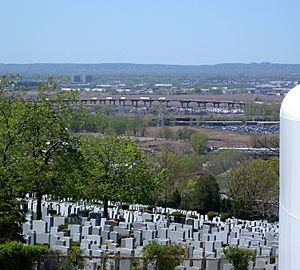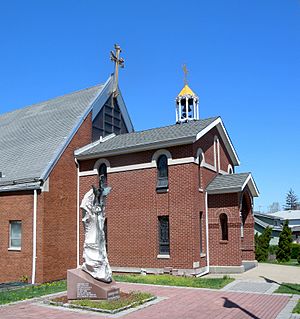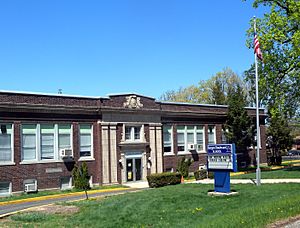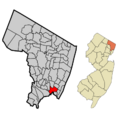Ridgefield, New Jersey facts for kids
Quick facts for kids
Ridgefield, New Jersey
|
||
|---|---|---|
|
Borough
|
||
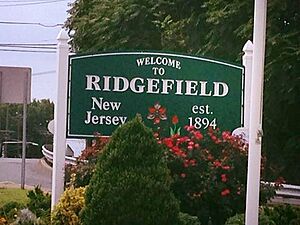 |
||
|
||
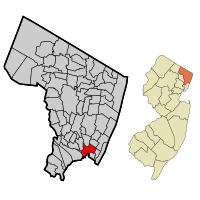
Location of Ridgefield in Bergen County highlighted in red (left). Inset map: Location of Bergen County in New Jersey highlighted in orange (right).
|
||

Census Bureau map of Ridgefield, New Jersey
|
||
| Country | ||
| State | ||
| County | Bergen | |
| Incorporated | May 26, 1892 | |
| Government | ||
| • Type | Borough | |
| • Body | Borough Council | |
| Area | ||
| • Total | 2.87 sq mi (7.43 km2) | |
| • Land | 2.54 sq mi (6.59 km2) | |
| • Water | 0.33 sq mi (0.85 km2) 11.39% | |
| Area rank | 345th of 565 in state 31st of 70 in county |
|
| Elevation | 10 ft (3 m) | |
| Population
(2020)
|
||
| • Total | 11,501 | |
| • Estimate
(2023)
|
11,417 | |
| • Rank | 218th of 565 in state 32nd of 70 in county |
|
| • Density | 4,522.6/sq mi (1,746.2/km2) | |
| • Density rank | 132nd of 565 in state 33rd of 70 in county |
|
| Time zone | UTC−05:00 (Eastern (EST)) | |
| • Summer (DST) | UTC−04:00 (Eastern (EDT)) | |
| ZIP Code |
07657
|
|
| Area code(s) | 201 | |
| FIPS code | 3400362910 | |
| GNIS feature ID | 0885367 | |
Ridgefield is a small town, called a borough, located in Bergen County, in the state of New Jersey. In 2020, about 11,501 people lived here. This was a small increase from 2010.
Ridgefield became an official borough on May 26, 1892. It was created from parts of Ridgefield Township. The town got its name because of its hilly land, which forms a "ridge."
Contents
History of Ridgefield
Early Native American Life
Long ago, before Europeans arrived, the Hackensack tribe of the Lenape people lived in this area. They were Native Americans. They had a large village near Overpeck Creek. Their name, Hackensack, means "place of stony ground." This describes the land where the Hudson Palisades hills meet the Meadowlands.
European Settlers Arrive
In 1642, a man named Myndert Myndertsen received a large land grant. This was part of the New Netherland colony. He called his settlement Achter Kol, meaning "rear mountain pass." This name described how easy it was to reach the land behind the Palisades.
Later, in 1655, a Native American leader named Oratam gave land to Sara Kiersted. She knew the native language and helped settlers and Native Americans talk to each other. By 1668, Samuel Edsall bought much of the land. It became known as the English Neighborhood. Most settlers there were Dutch and French Huguenots.
Growth and Development
In the mid-1800s, new railroads like the West Shore Railroad opened. This brought more people and businesses to Ridgefield. The town started to grow as a suburban area.
Ridgefield was also home to an artist's colony called Grantwood. It was started in 1913 by artists like Man Ray and Alfred Kreymborg. They lived in small houses on a bluff. Even today, some street names like Sketch Place and Art Lane remind us of this artistic past.
The New Jersey Turnpike was built in the 1950s. Its first northern end was in Ridgefield. Later, the Turnpike was extended to connect to Interstate 80 and the George Washington Bridge. This made travel much easier.
In the 1970s, the Hackensack Meadowlands Development Commission was formed. Its job was to help develop the area while protecting nature. Some low-lying areas, like Skeetkill Creek Marsh, are now nature reserves. They connect to the Overpeck Reserve and Overpeck County Park.
Geography of Ridgefield
Ridgefield covers about 2.87 square miles (7.43 square kilometers). Most of this is land, with a small part being water.
Neighboring Towns
Ridgefield shares its borders with several other towns. These include Carlstadt, Cliffside Park, Fairview, Fort Lee, Little Ferry, Palisades Park, Ridgefield Park, and South Hackensack. It also borders North Bergen in Hudson County.
Town Sections
Ridgefield is divided into three main parts based on its land shape:
- Ridgefield: This part is in the valley and on the first hill.
- Morsemere: This section is in the northern part of the borough. It was named after Samuel F. B. Morse, who invented the telegraph and Morse code. He owned a lot of land here.
- Ridgefield Heights: This area is on the second hill, at the far eastern side of the borough.
People in Ridgefield
| Historical population | |||
|---|---|---|---|
| Census | Pop. | %± | |
| 1900 | 584 | — | |
| 1910 | 966 | 65.4% | |
| 1920 | 1,560 | 61.5% | |
| 1930 | 4,671 | 199.4% | |
| 1940 | 5,271 | 12.8% | |
| 1950 | 8,312 | 57.7% | |
| 1960 | 10,788 | 29.8% | |
| 1970 | 11,308 | 4.8% | |
| 1980 | 10,294 | −9.0% | |
| 1990 | 9,996 | −2.9% | |
| 2000 | 10,830 | 8.3% | |
| 2010 | 11,032 | 1.9% | |
| 2020 | 11,501 | 4.3% | |
| 2023 (est.) | 11,417 | 3.5% | |
| Population sources: 1900–1920 1900–1910 1910–1930 1900–2020 2000 2010 2020 |
|||
In 2010, Ridgefield had 11,032 people living in 3,905 households. Many families lived here. About 29% of the people were of Asian background. A large part of the population, 25.7%, was Korean American.
The average household had about 2.82 people. About 21.6% of the population was under 18 years old. The median age was 41.5 years.
Education in Ridgefield
The Ridgefield School District teaches students from pre-kindergarten through twelfth grade. In the 2021–22 school year, there were 1,391 students and 160 teachers. This means there were about 8.7 students for every teacher.
The schools in the district are:
- Shaler Academy (PreK/Kindergarten)
- Bergen Boulevard School (Grades 1-2)
- Slocum-Skewes School (Grades 3-8)
- Ridgefield Memorial High School (Grades 9-12)
Students in Bergen County can also attend special high school programs. These are offered by the Bergen County Technical Schools. They include the Bergen County Academies in Hackensack. There is also the Bergen Tech campus in Teterboro or Paramus. Students apply to these schools, and their home school district pays the tuition.
Transportation
Roads and Highways
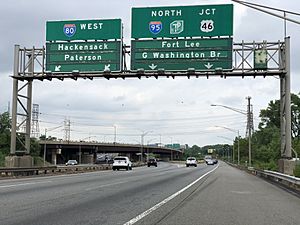
Ridgefield has many roads. As of 2010, there were about 31 miles of roadways. The town maintains most of these roads.
The New Jersey Turnpike (Interstate 95) goes through Ridgefield. The Turnpike's Vince Lombardi service area is located here.
Other important roads that pass through Ridgefield include U.S. Route 1/9, U.S. Route 46, Route 63, Route 93, and Route 5.
Public Transportation
NJ Transit provides bus service for people in Ridgefield. Buses go to and from the Port Authority Bus Terminal in Midtown Manhattan. They also go to Jersey City.
There are also plans for a light rail system called the Hudson–Bergen Light Rail. It might have a station in Ridgefield in the future. This would make it even easier for people to travel.
Notable People from Ridgefield
Many interesting people have lived in or are connected to Ridgefield. Here are a few:
- Tim Bogert (born 1944), a talented bass guitarist and singer.
- Marlene Caride (born 1963), a politician who served in the New Jersey General Assembly.
- Louise DeSalvo (1942–2018), a writer and professor known for her work on Virginia Woolf.
- Marcel Duchamp (1887–1968), a famous French artist.
- Gilbert Gaul (1855–1919), a painter known for his military and American Western art.
- Alfred Kreymborg (1883–1966), a poet and novelist.
- Man Ray (1890–1976), a very important painter and photographer in the Surrealist and Dada art movements. He had a house in Ridgefield's artist colony.
- Alexander Shaler (1827–1911), a general in the Union Army during the American Civil War. He later became the Mayor of Ridgefield, New Jersey.
- William Carlos Williams (1883–1963), a well-known poet.
Images for kids
See also
 In Spanish: Ridgefield (Nueva Jersey) para niños
In Spanish: Ridgefield (Nueva Jersey) para niños






